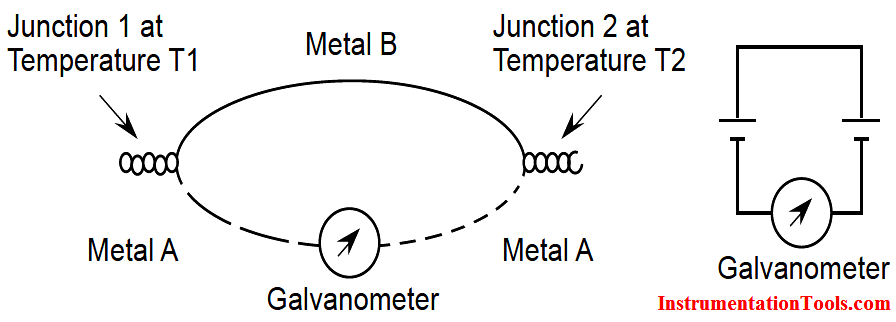A thermocouple consists of two pieces of dissimilar metals with their ends joined together (by twisting, soldering or welding). When heat is applied to the junction, a voltage, in the range of milli-volts (mV), is generated. A thermocouple is therefore said to be self-powered. Shown in Below Figure is a completed thermocouple circuit.

The voltage generated at each junction depends on junction temperature. If temperature T1 is higher than T2, then the voltage generated at Junction 1 will be higher than that at Junction 2. In the above circuit, the loop current shown on the galvanometer depends on the relative magnitude of the voltages at the two junctions.
In order to use a thermocouple to measure process temperature, one end of the thermocouple has to be kept in contact with the process while the other end has to be kept at a constant temperature. The end that is in contact with the process is called the hot or measurement junction. The one that is kept at constant temperature is called cold or reference junction. The relationship between total circuit voltage (emf) and the emf at the junctions is:
Circuit emf = Measurement emf – Reference emf
If circuit emf and reference emf are known, measurement emf can be calculated and the relative temperature determined.
To convert the emf generated by a thermocouple to the standard 4-20 mA signal, a transmitter is needed. This kind of transmitter is called a temperature transmitter. Below Figure shows a simplified temperature transmitter connection.
In Figure above, the temperature measurement circuit consists of a thermocouple connected directly to the temperature transmitter. The hot and
cold junctions can be located wherever required to measure the temperature difference between the two junctions.
In most situations, we need monitor the temperature rise of equipment to ensure the safe operation. Temperature rise of a device is the operating temperature using ambient or room temperature as a reference. To accomplish this the hot junction is located in or on the device and the cold junction at the meter or transmitter as illustrated in Below figure.
Thermocouple Advantages and Disadvantages
Advantages:
Disadvantages:
Failure Modes:
Thermal Wells / Thermo wells
The process environment where temperature monitoring is required, is often not only hot, but also pressurized and possibly chemically corrosive or radioactive. To facilitate removal of the temperature sensors (RTD and TC), for examination or replacement and to provide mechanical protection, the sensors are usually mounted inside thermal wells (Below Figure).
A thermal well is basically a hollow metal tube with one end sealed. It is usually mounted permanently in the pipe work. The sensor is inserted into it and makes contact with the sealed end.
A drawback to thermal wells is their long response time because heat must be transferred through the well to the sensor. An example of the temperature response for bare and thermal well installed sensors is shown in Below Figure. Minimizing the air space between the sensor and the well, however, can decrease this thermal lag.
In this article, a simple example will teach you the conversion from Boolean algebra to…
In this article, you will learn the PLC cooking timer example for kitchen automation using…
Learn an example PLC program to control a pump based on level sensors using ladder…
In the PLC timer application for security camera recording, when motion is detected then camera…
In this example, we will learn batch mixing with PLC ladder logic program using timer…
This PLC example on manufacturing line assembly is an intermediate-level PLC program prepared for the…
View Comments
how is wake frequency calculated?
Sir, main stream temperature in field 530, junction box 530,dcs will checked 532.after connected in dcs temperature card in cable (1,2)the dcs reading show in less then 100
Hi, How you checked at Field, Junction Box & DCS ? For thermocouple > Check millivolt signals at all points and must be same. If found same value then check your DCS Card or its configuration. For testing > Connect this thermocouple in spare channel > configure with same config > Check reading. Also Check for any cable induction voltage..